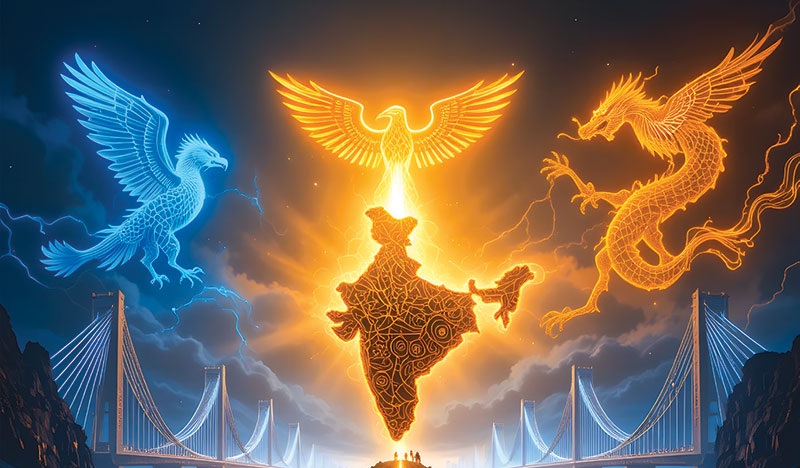Shishir Priyadarshi
India stands today at the crossroads of an unpredictable global order, caught between protectionist impulses in Washington, ambitious new trade partnerships in Europe, cautious cooperation with China and a deepening web of connectivity across its own neighborhood. Each development, while distinct, is woven into a larger story of how New Delhi navigates the competing demands of growth, security and diplomacy in a multipolar world.
Tariffs in Washington
The most immediate jolt has come from the United States. Washington’s decision to impose a fresh 25 per cent hike on Indian exports, effectively doubling duties on several categories to 50 per cent, has rattled policymakers and industry alike.
The move, justified by the Trump administration as a response to India’s continued purchases of discounted Russian oil and its alleged barriers to American goods, strikes at the heart of sectors such as textiles, seafood, jewellery and furniture.
It is a reminder that even as bilateral trade reached $131.84 billion in 2024–25, making the US India’s largest partner, overdependence on a single market carries risks. While IT services and pharmaceuticals remain insulated for now, New Delhi is being pushed to accelerate diversification of its export destinations, looking increasingly to Asean, Brics and the Latin American bloc for balance.
Deals with Europe
If Washington has unsettled New Delhi, Europe has offered opportunities. In July, India and the United Kingdom signed a long-awaited Free Trade Agreement (FTA), unlocking prospects for greater market access and service-sector cooperation.
This followed the Trade and Economic Partnership Agreement with the European Free Trade Association, concluded in March 2024, which seeks to boost investment and supply-chain integration. Yet Europe is no easy market to conquer.
The continent’s stringent quality and sustainability standards will demand sweeping reforms in Indian manufacturing, an overhaul of supply chains and a credible reduction of carbon footprints. Officials in New Delhi view this challenge as an opportunity: A chance to demonstrate that India can be both a driver of growth and a responsible global actor responsive to ethical and environmental concerns.
Cautious opening with China
China presents a more delicate picture. After years of deep mistrust, the visit of Foreign Minister Wang Yi to New Delhi in August produced what both sides described as a ten-point roadmap for cooperation. Agreements to resume direct flights, ease journalist visas and expand trade and cultural exchanges signaled a thaw in relations that had long been frozen by border tensions.
For India, the partnership offers undeniable benefits. China’s technological dominance in solar manufacturing is central to India’s renewable energy ambitions. Yet the fragility of trust cannot be ignored. Border disputes remain unresolved, and strategic competition across the Indo-Pacific continues. Analysts see the relationship not as a rapprochement, but as a form of managed competition, a pragmatic coexistence shaped by both necessity and suspicion.
Connectivity in neighbourhood
Closer home, India has been weaving a new fabric of regional connectivity. The most striking progress has come in the power sector. New Delhi has operationalised an agreement to import 10 gigawatts of electricity from Nepal over the next decade, with flows already crossing 1.1 gigawatts this monsoon.
Even more significant was the launch in June of a 40 megawatt power export from Nepal to Bangladesh via Indian grids, the first trilateral electricity trade in South Asia. These initiatives are positioning India as a regional energy hub, embedding trust and interdependence in the arteries of steel and current that crisscross the subcontinent. Diplomatic platforms such as Bimstec, the Asean corridors, Brics+ and the Quad are emerging not merely as forums for dialogue but as engines of investment, innovation and standard-setting.
Indo-Pacific stakes
Beyond its immediate borders, the Indo-Pacific looms large. From the Indian Ocean to the South China Sea, New Delhi has made maritime stability a priority, investing in naval cooperation, port governance and disaster-response frameworks. For coastal communities and fishermen, this is more than grand strategy: it is about ensuring livelihoods can depend on predictable, lawful order at sea.
Economic transformation at home
At the domestic level, India’s economic reconfiguration is being built on three pillars. The first is semiconductors. With more than $15 billion in new projects, including Tata-PSMC’s Dholera plant and Micron’s facility in Gujarat now entering production validation, India is stepping into the ranks of critical technology producers.
The second is green hydrogen. Under its national mission, New Delhi has set a target of five million tonne of annual production by 2030, underpinned by 125 gigawatts of renewable energy. The third is digital public infrastructure. India’s Unified Payments Interface, already linked to Singapore, Sri Lanka and Mauritius, with the UAE expected soon, has become a regional calling card of interoperability and trust, projecting digital governance as a form of soft power.
Challenges ahead
Yet the path ahead is far from smooth. Geopolitical flashpoints remain alive, from fragile borders to uneasy neighborhood politics. The pace of domestic reform — in transparency, regulation and skilling — will determine whether India can seize the benefits of global partnerships. And the governance of technology, from privacy and cybersecurity to data localisation, requires coherent national policy aligned with regional and global norms.
The road forward
The larger challenge is to ensure that India’s growth is inclusive, that the dividends of trade and technology translate into jobs, opportunity and human development. Strategic advantage does not lie in GDP numbers alone, but in the ability to act as a bridge between civilisations, a convenor of dialogue and a magnet for innovation. In the end, India’s region is not a problem to be managed but a network of opportunities to be nurtured. The task before policymakers is to diversify boldly, govern pragmatically and lead with climate and connectivity. Resilience, pragmatism and innovation will decide whether today’s disruptions become tomorrow’s strengths.



